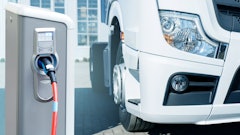
Almost immediately following the onset of the pandemic, many organizations, including transportation fleets, rushed to digitize their operations to reduce the handling of paper-based contracts and documents. Today, organizations are increasingly digitizing for a number of business benefits unrelated to the pandemic, which has resulted in significant efficiencies for transportation fleets and their financing partners.
Contracts are the lifeblood of relationships between lenders, partners, and customers such as organizations with heavy-duty transportation fleets. Technology has enabled the modernization of company processes, and this has resulted in reducing their reliance on paper contracts. This shift not only improves the speed and efficiency of transactions, but also ensures greater security and compliance with stringent regulations for equipment financing.
The transition to digital contracts also addresses concerns related to document storage and access control. Digitization enables better protection of documents during transfers between the transportation fleets and their finance partners, as an example. Recognizing the inefficiencies in paper-based processes, transportation fleets and their finance partners are actively seeking to minimize their reliance on physical paperwork. This shift is particularly seen in many industries that operate private fleets, such as construction.
In terms of how companies have contracted partnerships with transportation fleets, for example, about 7.5% of all documents end up getting lost, which is a significant reason why keeping everything digital today is extremely effective.
Delivering more accuracy and efficiency
To be clear, paper is still used throughout the industry, but through digital transformation, companies are realizing a more effective alternative in solving several key pain points for the industry.
First and foremost, digitization will significantly improve the accuracy and added costs to manage paper, keeping up with revisions, etc. What’s more, digital contracts not only reduce the risk of using outdated agreements, but also facilitate smoother interactions between the lender and the truck dealer or business.
Today’s transportation fleets and their finance partners recognize the importance of digitization, and they have seen significant enhancements including faster processing, streamlined workflows and a more reliable, trusted document handling system. Managers like the ease of logging in, reviewing, and signing their documents which automatically pushes the document to the next approver.
What’s more, aside from e-signatures and digital contracting, the electronic storage of these contracts is crucial for all parties involved, ensuring secure access and facilitating audits.
Digital contracting will only grow in prominence, so equipment financiers should recognize this if they want to be considered leaders of tomorrow. According to industry data from Markets and Markets, the global digital signature market size is projected to grow from $7.4 billion in 2023 to $34.8 billion by 2028, a CAGR of 36% during that time. Leading companies in their respective industries will quickly turn toward digitizing their contracts and signatures.
The next phase of contracting digital transformation will involve leveraging advanced workflow processes such as e-contracting, multi-channel origination, digital certainty, auditing, document governance, security, post-transaction asset management and analysis tasks. Each of these areas may seem mundane to the average person, but they each remain critical for the industry to evolve to the next chapter of digitalization.
Centralized data management will allow transportation fleets and their finance professionals to access and analyze metadata across various origination channels and asset classes.
What’s more, it will help to control and track access, manage status changes, and transfer control of digital documents while utilizing sophisticated granular controls and permissions to allow for departmental separation and visibility. All of this will result in improved speed and process efficiency for the entire industry.
Despite the numerous benefits of digital transformation, some organizations have been slow to adopt these changes. Challenges, such as legacy internal processes, user resistance, and concerns about software costs have hindered progress for some. However, delaying this adoption of digital solutions will result in a significant competitive disadvantage.
With these enhancements, the equipment finance and transportation fleet industries can advance in digital transformation. From origination transactions to back-office operations, digital transformation can revolutionize how original equipment manufacturers (OEMs), dealers, equipment financiers and the fleets themselves operate and collaborate.


















